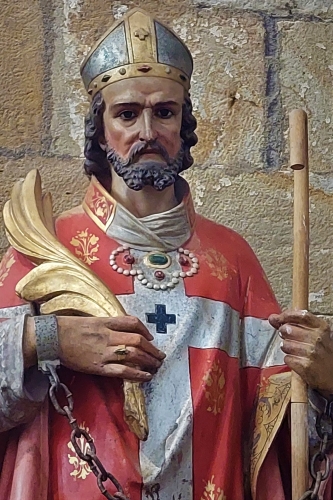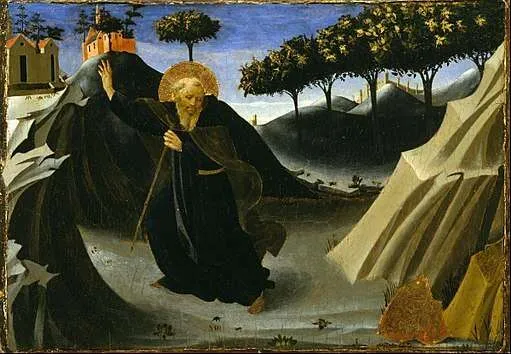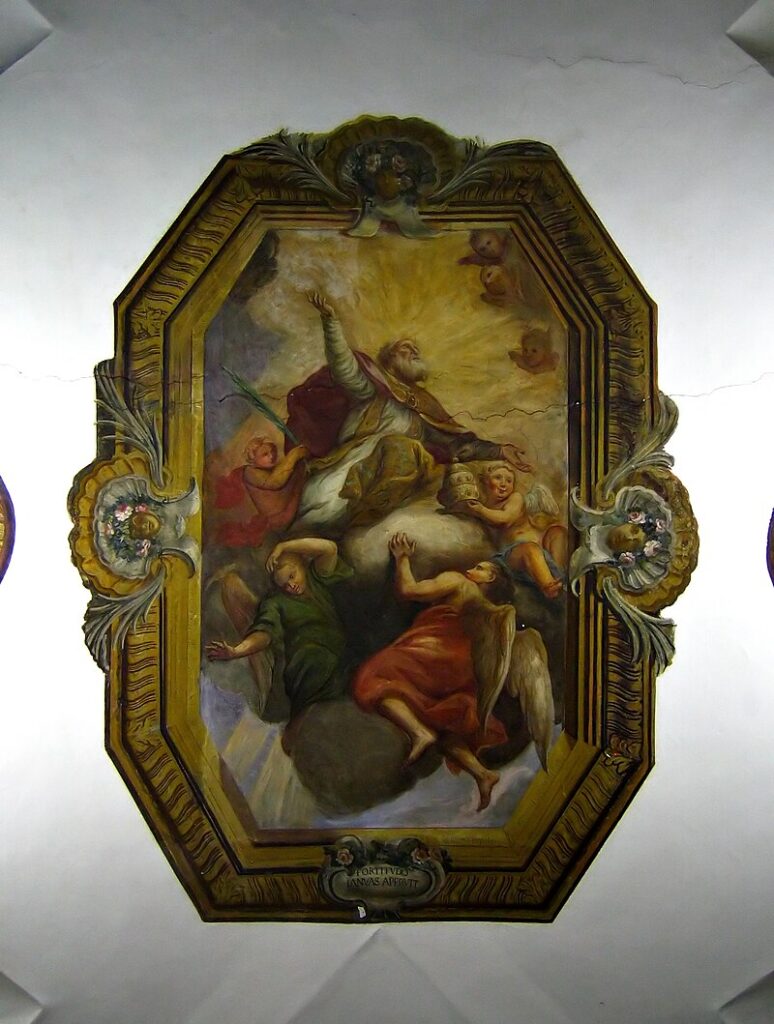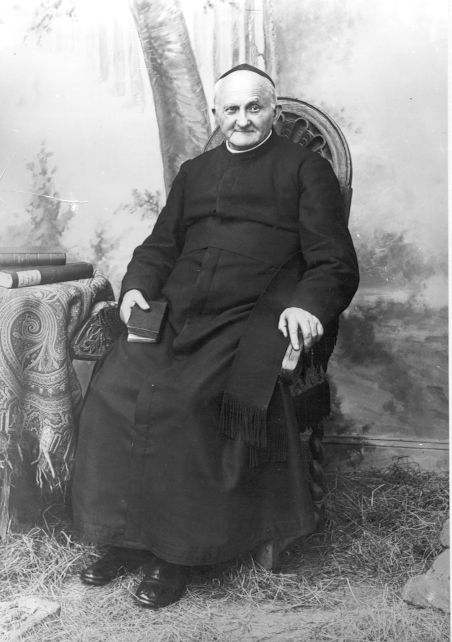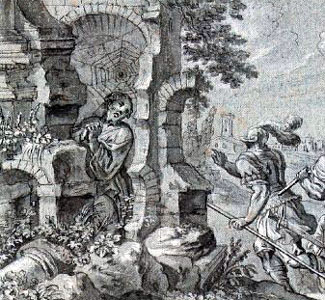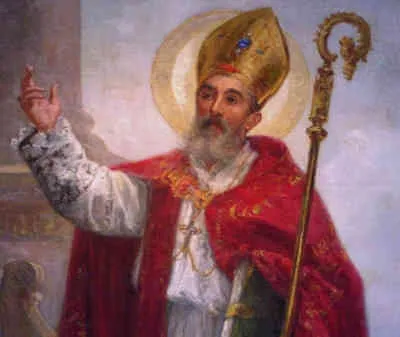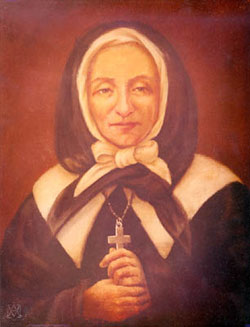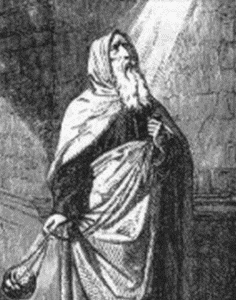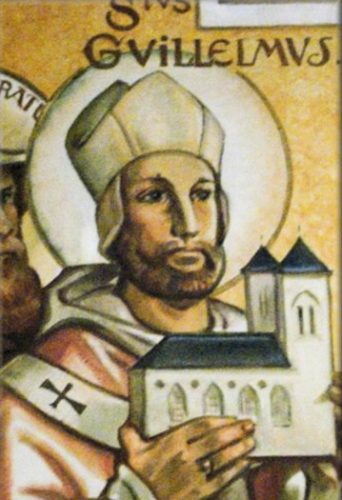Saint Volusian of Tours
Saint Volusian of Tours Read More »
Profile
As a layman, Volusian suffered through years of a terrible marriage. He was an Imperial Roman senator at Tours, France.
Volusian was a Bishop of Tours in 488. He was exiled to Spain in 496 by Arian Visigoths. He may have been martyred, but records are unclear.
Died
Canonized
Patronage
Source: https://catholicsaints.info/saint-volusian-of-tours/
Saint Volusian of Tours Read More »
Anthony was born into an upper-class Catholic home. His parents raised Anthony and his younger sister in a small village in southern Egypt. He received a basic education and was twenty years old when his parents suddenly died. He was left with a large inheritance and the responsibility of caring for his sister. Some months later, Anthony was attending Mass and heard the Gospel story of Jesus’ command to the rich young man: “If you wish to be perfect, go, sell what you have and give to the poor, and you will have treasure in heaven” (Matthew 19:21).
As Anthony heard these words, he knew Jesus was speaking directly to him. Shortly after, he gave away most of his property, sold almost everything else, and kept only what he needed to care for himself and his sister. But that’s not exactly what the Lord had commanded! Jesus said that perfection is obtained only if one were to sell everything and give it to the poor.
Not long afterward, Anthony was at Mass once again and heard the Gospel passage, “Do not worry about tomorrow; tomorrow will take care of itself” (Matthew 6:34). Again, he knew Jesus was speaking directly to him, so he gave away even the little he had saved back, entrusted his sister to the care of some holy women, and entered the desert to live a life of poverty, solitude, prayer, and mortification.
In that harsh desert landscape, the devil attacked him in countless ways. “Think about all the good you could have done with that money you gave away!” These were the words of the evil one, trying to deter Anthony from embracing his unique vocation as a hermit. Then the devil appeared to him in physical form and sent vile creatures to frighten him. Satan tempted Anthony with boredom, laziness, and even appeared as a female temptress to seduce him. Firm in prayer and mortification, Anthony fought off the devil and his manifestations. Though beaten senseless during these spiritual battles, he recovered in the care of some friends who visited him.
After spending fifteen years living in a desert cave once used as a tomb, Anthony retreated even deeper into solitude, spending another twenty years in self-imposed solitary confinement. He ate only bread that friends threw over the wall of the abandoned Roman fort he called home. He never opened his mouth to speak to anyone, for God called him to the unique life of complete solitude.
Eventually, Anthony’s holy example stirred up devotion and admiration in the hearts of others. Though they could not speak to him, many wanted to imitate him. They began to build huts nearby and imitate his vocation. Then, after twenty years of solitude, God directed Anthony to exit his fort and assist the other nearby hermits with their vocations. For the next five years, he instructed the new hermits on how to organize their lives.
Anthony then withdrew once again into seclusion for the last forty-five years of his very long life. However, this time he did accept visitors from time to time and even entered nearby cities to occasionally preach and teach. Most notably, he preached firmly against the rampant Arian heresy, directly opposed the emperor for persecuting Christians, and fearlessly offered himself up to be martyred.
God did not grant his desire for martyrdom, however. Instead, Anthony lived to the ripe old age of 105. He made a powerful impact upon the lives of many by his radical obedience to God’s will, through his life devoted to prayer, his embrace of poverty, his courageous preaching against heresy, and his assistance to those daring to live as hermits. He was so influential that another heroic saint of that time, the bishop Saint Athanasius, wrote a biography of Saint Anthony, supplying much of what we know about him today.
Source: https://mycatholic.life/saints/saints-of-the-liturgical-year/january-17-st-antony-patriarch-of-monks/
Saint Anthony of Egypt, Abbot Read More »
Profile
Nothing of Marcellus’ life before the papacy has survived the centuries. He was Pope at the end of the persecutions of Diocletian; the persecutions had so disrupted the Church that there had been a gap of over a year with no Pope.
Marcellus faced reconstituting the clergy which had been decimated and whose remnant had practiced their vocation covertly and with the expectation of martyrdom. He worked to recover and welcome back those who had denied the faith to keep from being murdered.
When a group of people apostatized before and during a period of persecution refused to do penance in order to return to the Church (they were known as the Lapsi), Marcellus refused to allow their return to the Church. This group had some political pull, and some caused such civil disruption that Emperor Maxentius exiled the Pope in order to settle the matter. Legend says that Marcellus was forced to work as a stable slave as punishment, but this appears to be fiction.
Marcellus was considered a martyr as he died of the terrible conditions he suffered in exile.
Papal Ascension
Died
Canonized
Patronage
Representation
Source: https://en.wikipedia.org/wiki/Pope_Marcellus_I#/media/File:Roma-sanmarcelloalcorso2.jpg
Pope Saint Marcellus I
Pope Saint Marcellus I Read More »
Profile
Arnold felt an early call to the priesthood, and was ordained in August 1861. Well educated, he taught science and catechism for twelve years.
Arnold was a chaplain and director of the Ursuline convent at Kempen in 1873. He was the Director of the diocesan Apostleship of Prayer in 1874, and was an editor of a journal about missionary work in 1873.
Arnold established the religious congregation Society of the Divine Word in Steyl, Netherlands in 1875; it received papal approval in 1901. The Society, which soon had houses in the Netherlands, Austria, and Germany, was composed of missionary priests who worked in Tonga, New Guinea, Japan, Paraguay, and throughout North America.
In 1889, Arnold founded the Missionary Sisters, Servants of the Holy Ghost to assist the priests in their mission. The Sisters serve as teachers in mission lands, especially of young girls. With the help of Blessed Maria Virgo, Arnold formed the sisters a contemplative branch named Sister Servants of the Holy Spirit of Perpetual Adoration who devote themselves to adoration of the Blessed Sacrament, and prayer for the success of missionary efforts. These sisters are nicknamed Pink Sisters because of the color of their habit.
Born
Died
Venerated
Beatified
Canonized
Source: https://en.wikipedia.org/wiki/Arnold_Janssen#/media/File:Arnold_Janssen.jpg
Saint Arnold Janssen
Saint Arnold Janssen Read More »
Profile
Felix was the elder son of Hermias, a Syrian soldier who had retired to Nola, Italy. After his father‘s death, Felix sold off most of his property and possessions, gave the proceeds to the poor, and pursued a clerical vocation. He was ordained by, and worked with Saint Maximus of Nola.
When Maximus fled to the mountains to escape the persecution of Decius, Felix was arrested and beaten for his faith instead. Legend says he was freed by an angel so he could help his sick bishop. Felix hid Maximus from soldiers in a vacant building. When the two were safely inside, a spider quickly spun a web over the door, fooling the imperial forces into thinking it was long abandoned, and they left without finding the Christians. The two managed to hide from authorities until the persecution ended with the death of Decius in 251.
After Maximus‘ death, Felix was chosen as bishop of Nola, but declined, favoring Quintus, a “senior” priest who had seven days more experience than Felix. He worked to farm his remaining land, and gave most of the proceeds to people even poorer than himself. Much of the little information we have about Felix came from the letters and poetry of Saint Paulinus of Nola, who served at a porter at the door of a church dedicated to Saint Felix, and who gathered information about him from churchmen and pilgrims.
Though Felix died of natural causes, he is normally listed as a martyr because of the torture, imprisonment, and privations he experienced in the persecutions.
Born
Died
Canonized
Patronage
Representation
Source: https://catholicsaints.info/saint-felix-of-nola/
Saint Felix of Nola Read More »
Born into a wealthy pagan family in Poitiers, France, Hilary was well educated in the classics. As he looked into his own soul, however, he knew that he did not exist for the sole purpose of seeking pleasure, enjoying leisure, obtaining wealth, or merely satisfying his fleshly desires.
Hilary reasoned that the human soul did not exist simply to die. Instead, it must exist for something more, something eternal, something glorious. When his pagan culture did not suffice and philosophy fell short, Hilary finally found what he was searching for when he stumbled upon the Scriptures.
Hilary was first struck by the mysterious name of God in the Old Testament: “I AM WHO I AM.” God had revealed Himself as eternal, without beginning or end—Existence itself. Then Hilary discovered the Son of God in the Gospel of John 1:1–14. Of this discovery, Hilary said, “My soul measured the mighty workings of God, wrought on the scale of His eternal omnipotence . . .by a boundless faith . . .that God was in the beginning with God, and that the Word became flesh and dwelt among us . . .” (De Trinitate 1.12).
Hilary had the will to believe, and in the years that followed he was given the power and gift to understand the beauty, mystery, omnipotence, and nature of the Most Holy Trinity. Shortly after these discoveries of faith, Hilary was baptized a Christian and went on to defend the doctrine of the Trinity against the “insanity and ignorance of men.” He so impressed the faithful that they chose him to be their bishop, a dignity to which he reluctantly agreed.
Among those who shared in the “insanity and ignorance” of that time were a group of bishops and laity who followed the heresy of Arianism, which denied the divinity of Christ, instead holding that the Son was inferior to the Father. This heresy was especially strong in the Eastern Church but was starting to spread throughout France.
After Hilary was a bishop for only about five years, the emperor, an Arian himself, ordered every bishop to pledge their support for this heresy. Hilary refused. Instead, he vigorously defended the truth, and for his brave stance was exiled to Phrygia, in modern-day Turkey. In His love and providence, God used Hilary’s time of exile in powerful ways.
While in Phrygia, Bishop Hilary spent much time studying and writing. He had already composed a marvelous commentary on the Gospel of Matthew while in Poitiers, and now he set his mind to his greatest work, De Trinitate (On the Trinity). Drawing from his classical education, his knowledge of Greek, his love of the Scriptures, and from the “insanity” and “ignorance” of Arianism itself, Bishop Hilary composed a comprehensive defense of the doctrine of the Trinity as it was taught in the Nicene Creed. Bishop Hilary caused so much trouble for the Arians in Phrygia that the Arian bishops pleaded with the emperor to send him back home, a request the emperor honored.
On his return to Poitiers, Bishop Hilary took the long way home through Greece and Italy, preaching all the way, weeding out the beginnings of Arianism in the Western Church. His effectiveness came not only from his clear teaching, but also from his conciliatory approach and resolute determination. Back in Poitiers, he continued to preach, write, attend councils, and even to compose hymns. The hymns were his way of introducing the doctrines of the faith to the people of God in song. He was a true pastor who burned with a desire that everyone come to a deeper knowledge of the One God—Father, Son, and Holy Spirit.
Source: https://mycatholic.life/saints/saints-of-the-liturgical-year/january-13-saint-hilary-of-poitiers-bishop-and-doctor/
Saint Hilary of Poitiers, Bishop and Doctor Read More »
Profile
Marguerite was the sixth of twelve children of devout parents. When Marguerite was 19, her mother died, and the young lady cared for her younger brothers and sisters; her father died when she was twenty-seven. After raising her family, Marguerite prayed to know what to do with her life. The governor of Montreal, Canada, was in France looking for teachers for the New World. He invited Marguerite to come to Montreal to teach school and religion classes. She agreed and spent the rest of her life in North America.
Marguerite gave away her share of her parents’ inheritance to other members of the family, and in 1653, she sailed for Canada. She began construction of a chapel to honor Our Lady of Good Help, and opened her first school in 1658. She returned to France in 1659 to recruit more teachers, and returned with four; in 1670, she went to France again, and brought back six more. These brave women became the first sisters of the Congregation of Notre Dame.
Marguerite and her sisters helped people in the colony survive when food was scarce, opened a vocational school, taught young people how to run a home and farm. Marguerite’s congregation grew to 18 sisters, seven of them were Canadian. They opened missions, and two sisters taught at the Native American mission. Marguerite received the first two Native American women into the congregation.
In 1693, Mother Marguerite handed over her congregation to her successor, Marie Barbier, the first Canadian to join the order. Marguerite’s religious rule was approved by the Church in 1698, and Marguerite spent her last few years praying and writing an autobiography. On the last day of 1699, a young sister lay dying. Mother Marguerite asked the Lord to take her life in exchange. By the morning of 1 January 1700, the sister was completely well, Mother Marguerite had a raging fever, suffered 12 days, and died on 12 January 1700.
Born
Died
Venerated
Beatified
Canonized
Patronage
Source: https://catholicsaints.info/saint-marguerite-bourgeous/
https://www.catholic.org/saints/saint.php?saint_id=1373
Saint Marguerite Bourgeous Read More »
Profile
Born to a pious family, Theodosius began his studies at an early age, and became a lector while still a youth. The example of Abraham led him to leave home in order to properly follow God. He met Saint Simeon Stylites in Antioch; Simeon recognized him as a holy man and leader, and invited Theodosius onto his pillar for prayer, blessing, and advice. He travelled to Jerusalem where legend says he worked with Saint Longinus the Centurian, who would have been nearly 500 years old at the time. He was also a head of a church near Bethlehem.
Theodosius was a hermit in the desert of Judah, living in a cave. Word of his holiness began to attract disciples, and Theodosius built a monastery at Cathismus to house them. They were so many there had to be a section for Greeks, for Armenians, for Persians, etc., but they all happily worked and prayed together. Next to the monastery he built a hospital for the sick, a hospice for the aged, and a mental hospital. He was a friend of and co-worker with Saint Sabbas. Appointed visitor to all cenobitical communities of Palestine the patriarch of Jerusalem.
Opposed heresies, including Eutychianism and Monophysitism. Emperor Anastatius, a supporter of Eutychianism, sent Theodosius a large bribe, hoping to sway the influential monk to his thinking; Theodosius distributed the money to the poor, and continued to preach against heresy. Because of his orthodox views, Anastatius removed him from his position in 513, but he soon resumed his duties under emperor Justinian.
In poor health in his old age, he was stricken with a condition that made his skin dry as stone. He continued to work until his health gave out, and then he spent his time praying for his community. He died at age 105.
Born
Died
Canonized
Name Meaning
Representation
Patronage
Source: https://catholicsaints.info/saint-theodosius-the-cenobiarch/
Saint Theodosius the Cenobiarch Read More »
Profile
William was a member of the family of the Counts of Nevers. His father, Baldwin, planned a military life for him. He was educated by his maternal uncle, Peter the Hermit, archdeacon of Soissons, France. Drawn to religious life from an early age, William became a priest, canon in Soissons, and later in Paris.
William was a monk in the Order of Grandmont, noted for his austerities, his devotion to the Blessed Sacrament, and for the time spent praying at the altar. Internal dissension in the Order caused him to leave Grandmont for the recently formed Cistercians, taking the habit at Pontigny.
William was an abbot at Fontaine-Jean in Sens, France and at Chaalis near Senlis, France in 1187.
William was reluctant in being the Archbishop of Bourges, France in 1200, accepting the position only after receiving orders from the general of his order, and from Pope Innocent III. He lived an even more austere life, defended clerical rights against the state, cared personally for the poor, sick, imprisoned and debauched, and converted many Albigensians in his diocese to orthodox Christianity. Witnesses claim he performed 18 miracles during his life, and another 18 after his death.
Born
Died
Canonized
Source: https://en.wikipedia.org/wiki/William_of_Donjeon#/media/File:Saint_Guillaume_de_Bourges.jpg
Saint William of Bourges
Saint William of Bourges Read More »
Profile
In the mid-640‘s, Adrian’s family fled to Naples, Italy ahead of the Arab invasion. He was quite young when he became a Benedictine monk. He was an abbot of Hiridanum, Isle of Nisida, Bay of Naples. He became acquainted with Emperor Constans II, who later introduced him to Pope Saint Vitalian. He later on became Vitalian’s advisor.
Adrian was twice offered the Archbishopric of Canterbury, England; he declined, citing unworthiness. When Saint Theodore of Tarsus was sent instead, Adrian went as his assistant with special support to aid the monastic movement in the region.
Adrian was detained in France due to suspicions of espionage for the emperor. He arrived in England in 669. He became an abbot of Saint Peter‘s, a monastery founded by Augustine of Canterbury.
Adrian and Theodore were highly successful missionaries in largely pagan England. In addition, Adrian was a great teacher of languages, mathematics, poetry, astronomy, and Bible study. Under his leadership, the School of Canterbury became the center of English learning. He worked to unify the customs of the English with the Church, and to promote Roman customs.
Born
Died
Canonized
Patronage
Source: https://catholicsaints.info/saint-adrian-of-canterbury/
Saint Adrian of Canterbury Read More »
Add San Jose Filipino Ministry as a new recipient, Send your donation using"[email protected]"
Payable to - San Jose Filipino Ministry
Address - 1235 S Magnolia Ave Anaheim, CA 92804-5115
1235 S.Magnolia Ave. Anaheim, CA 92804-5115
1235 S.Magnolia Ave. Anaheim, CA 92804-5115
Add San Jose Filipino Ministry as a new recipient, Send your donation using"[email protected]"
Payable to - San Jose Filipino Ministry
Address - 1235 S Magnolia Ave
Anaheim, CA 92804-5115
San Jose Filipino Ministry. All rights reserved. 2021 © Powered by Phoenix Virtual Solutions
Sponsored by EverClear Hospice and Palliative Care
